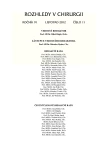Vascular reconstructions infections in the aortofemoral region
Authors:
V. Třeška; B. Čertík; J. Moláček; K. Houdek; M. Čechura; R. Šulc; J. Fichtl; J. Doležal; M. Polák
Authors‘ workplace:
Chirurgická klinika FN a LFUK v Plzni, přednosta: Prof. MUDr. V. Třeška, DrSc.
Published in:
Rozhl. Chir., 2012, roč. 91, č. 11, s. 597-600.
Category:
Original articles
Overview
Introduction:
The incidence of prosthetic vascular graft infections in the aortofemoral region is reported at 0.6–3%. These complications are burdened with a high mortality of up to 50% and an amputation rate of up to 20%. The aim of our study was to give a complex view on the diagnostic and treatment possibilities of these serious complications of reconstructive vascular surgery.
Material and methods:
Prosthetic bypass grafts were performed in 1088 patients in the aortofemoral region between 2001–2011 at the Department of Surgery, Teaching Hospital and the Faculty of Medicine, Charles University, in Pilsen. 24 (2.2%) patients suffered from graft infection at various time intervals after primary vascular reconstruction. Clinical examination, computed tomography and positron emission tomography were the main diagnostic methods of vascular graft infection. “In situ” reconstructions dominated over extra-anatomic reconstructions. When the infection involved only the peripheral part of the prosthetic graft, a more conservative approach – local debridement and drainage – was used.
Results:
The mortality of the patients was 20.8%, high amputation rate 12.5%, and morbidity rate 58.3%, respectively. The average time of hospitalization in surviving patients was 46.5 days. Primary 30-day patency rate in “in situ” and extra-anatomic reconstructions was 100 and 60%, respectively.
Conclusion:
Prosthetic vascular graft infections in the aortofemoral region require tailored multidisciplinary treatment approach in vascular centres. “In situ” reconstructions are the method of first choice. A more conservative approach in infections involving only the peripheral part of the vascular reconstruction has a positive treatment effect.
Key words:
vascular reconstructions – aortofemoral region – infections – diagnosis – treatment
Sources
1. Herman J, Utíkal P, Sekanina Z, Bachleda P. Infekce náhrad abdominální aorty. Rozhl Chir 2009;88(7):349–352.
2. OęConnor S, Andrew P, Batt M, Becquemin JP. A systematic review and meta-analysis of treatments for aortic graft infection. J Vasc Surg 2006;44:38–45.
3. Healy AH, Reid BB, Allred BD, Doty JR. Antibiotic-Impregnated beads for the treatment of aortic graft infection. Ann Thorac Surg 2012;93:984–985.
4. Calligaro KD, Veith FJ, Yuan JG, Gargiulo NJ, Dougherty MJ. Intra-abdominal aortic graft infection: Complete or partial graft preservation in patients at very high risk. J Vasc Surg 2003;38:1199–1205.
5. Larena-Avellaneda A, Russman S, Fein M, Debus ES. Prophylactic use of silver-acetate-coated graft in arterial occlusive disease: A retrospective, comparative study. J Vasc Surg 2009;50: 790–798.
6. Hart JP, Eginton MT, Broiwn KR, Seabrook GR, Lewis BD, Edmiston ChE, Towne JB, Cambria RA. Operative strategies in aortic graft infections: Is complete graft excision always necessary? Ann Vasc Surg 2005;19:154–160.
7. Ali AT, Modrall G, Hocking J, Valentine J, Spencer H, Eidt JF, Clagett P. Long-term results of the treatment of aortic graft infection by in situ replacement with femoral popliteal vein grafts. J Vasc Surg 2009;50:30–39.
8. Gardet E, Addas R, Monteil J, Le Guyader A. Comparison of detection of F-18 fluorodeoxyglucose positron emission tomography and 99m Tc-hexamethylpropylene amine oxide labelled leukocyte scintigraphy for an aortic graft infection. Interact CardioVasc Thorac Surg 2010;10:142–143.
9. Aavik A, Lieberg J, Kals J, Pulges A, Kals M, Lepner U. Ten years experience of treating aorto-femoral bypass graft infection with venous allografts. Eur J Vasc Endovasc Surg 2008;36: 432–437.
10. Garg N, Kalra M. Novel extra-anatomic intra-abdominal reconstruction for treatment of paravisceral aortic infection. J Vasc Surg 2012;55:599–602.
11. Oderich GS, Bower TC, Cherry KJ, Panneton JM, Sullivan TM, Noel AA, Carmo M, Cha S, Kalra M, Gloviczki P. Evolution from axillofemoral to in situ prosthetic reconstruction for the treatment of aortic graft infections at a single center. J Vasc Surg 2006;43:1166–1174.
12. Staffa R, Kříž Z, Vlachovský R, Dvořák M, Novotný T, Buček J, Sárník S, Vojtíšek B. Autogenní povrchní stehenní žíla jako náhrada infikované aorto-iliko-femorální cévní rekonstrukce. Rozhl Chir 2010;89:39–44.
13. Kieffer E, Gomes D, Chiche L, Fléron LCh, Koskas F, Bahnini A. Allograft replacement for infrarenal aortic graft infection: Early and late results in 179 patients. J Vasc Surg 2004; 39: 1009–1017.
14. Batt M, Jean-Baptiste E, OęConnor S, Bouillanne PJ, Haudebourg P, Hassen-Khojda R, Declemy S, Farhad R. In-situ revascularisation for patients with aortic graft infection: A single centre experience with silver coated polyester grafts. Eur J Vasc Endovasc Surg 2008;36:182–188.
15. Brown KE, Heyer K, Rodriquez H, Eskandari M, Pearce WH, Morasch MD. Arterial reconstruction with cryopreserved human allografts in the setting of infection: A single-center experience with midterm follow-up. J Vasc Surg 2009;49:660–666.
Labels
Surgery Orthopaedics Trauma surgeryArticle was published in
Perspectives in Surgery

2012 Issue 11
Most read in this issue
- Repeated surgery for parathyroid carcinoma
- Current microsurgical and neurointerventional therapy of cerebral aneurysms
- The NanoKnife and two successful cases of intracavitary irreversible electroporation of main bronchus tumours
- Postoperative pancreatic fistula management by gastrofistuloanastomosis – a set of case reports
